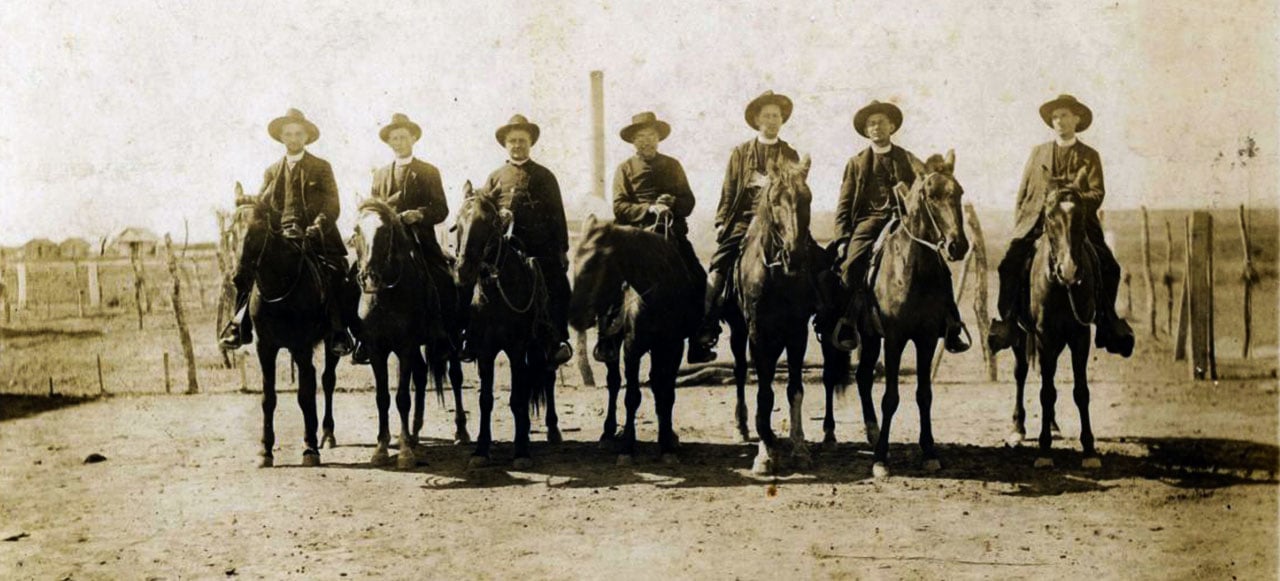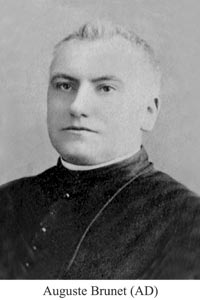Born in Pont-en-Royans (Isère), October 7, 1816
Taking of the habit in N.-D. de l’Osier, August 14, 1841
Oblation in N.-D. de l’Osier August 15, 1842 (No.95)
Ordination to the priesthood in Longueuil, August 29, 1844
Died in Montreal, June 27, 1866.
Alexandre Auguste Brunet [was born October 7, 1816, at Pont-en-Royans, Isère, son of Jean-Baptiste Brunet, a merchant, and Marie Blain.] He attended the College of Saint-Marcellin and the Petit Séminaire de Côte-Saint-André, diocese of Grenoble. In 1837 he joined the army but left it the following year and completed his studies at the Petit Séminaire. He was admitted to the novitiate of the Oblates of Notre-Dame de l’Osier on 14 August, 1841, took his perpetual vows there on 15 August 1842 and began his theological studies. He was sent to Canada at the end of 1843, and Bishop Ignace Bourget ordained him priest at Longueuil on 29 August 1844.
Father Brunet and Father Eusèbe Durocher were the first Oblates to undertake the difficult work as missionaries to the lumber camps on the Gatineau and Ottawa rivers. He went there as early as January 1845 but in November returned to Longueuil to devote himself to parish missions. He was recalled to the lumber camp mission in 1849, and lived at Bytown (Ottawa) where he ministered to young lumbermen on their way through town. He was also engaged in directing the seminarians and gave a few courses at the local college. At the same time he took charge of preaching and was chaplain at the mother house of the Grey Nuns. His favourite work, however, was in the lumber camps among the employees whom he visited regularly and called his “dear children.” Brunet left a small manu entitled “Le guide des voyageur” dedicated to Joseph Bruno Guigues, bishop of Bytown. The work, drafted after 1848, contains a series of canticles, a kind of treatise on the “temporal and spiritual duties of the voyageur” and “religious exercises for the voyageur.” The canticles, set to familiar tunes such as “Quand Marianne s’en va au moulin” or “Un Canadian errant,” showed the missionary’s concern to adapt himself to the mentality of the faithful. In September 1855 Brunet had to give up his ministry because of poor health. he went to the Oblate residence of Saint-Pierre-Apôtre at Montreal, to devote himself once more to popular preaching in Canada and in several American dioceses.
At this time the preaching in Illinois of the former Oblate, Charles Pascal Télesphore Chiniquy, was attracting people away from the Roman Catholic Church, and Bishop Anthony O’Regan of Chicago turned to Bishop Bourget for assistance. The latter passed on the request to Mgr Guigues who demurred somewhat, asserting that the mission was far away and they were short of men; finally, in October 1858, Fathers Lucien Antoine Lagier and Brunet were sent to fight the schism. They exercised their apostolate first at Bourbonnais; then Brunet went to Kankakee while Lagier took over the mission in St. Anne, Illinois. Following their preaching, “about 150 schismatics” returned to the practice of the Catholic religion. When the missionaries were preparing to return to Canada, Chiniquy had Father Brunet arrested, “on the false pretext,” Le Canadien wrote, “that the reverend Father had accused him of having had the church at Bourbonnais burned down in 1853.” Thanks to a bond of more than $2,000 put up by the Catholics of Kankakee, Brunet was able to return immediately to Canada. Chiniquy brought a libel action against Brunet, however, in the circuit court of Kankakee, which began on 13 April 1859. The missionary was ordered to pay Chiniquy damages amounting to $4,625. An appeal was launched and a new trial was held in January 1860. The jury sustained the verdict of guilty but reduced the fine to $2,500. The bishop of Chicago then decided to bring the case before the United States Supreme Court, but later abandoned the plan. Brunet declared himself insolvent and was forced to go to prison in May of 1861. He thus obliged Chiniquy to pay his board in prison, instead of his paying Chiniquy the damages fixed by the judge. An enterprising Catholic managed to engineer Brunet’s escape after three months of confinement, and the priest returned to Montreal in August. The affair seems to have had no sequel.
Even though his imprisonment played a large part in destroying his already impaired health, Brunet nonetheless continued to preach until he was stricken with paralysis in 1866. He died in June, leaving behind him the memory of a good-humoured and simple man who had distinguished himself by his zest for work.
Gaston Carrière, O.M.I.

